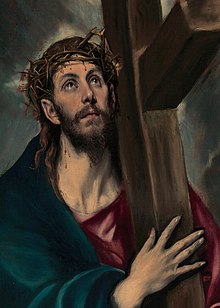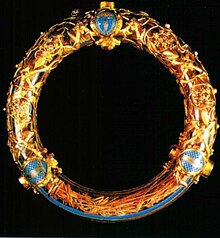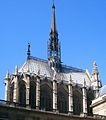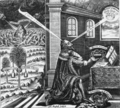Crown of thorns

According to the

Since at least around the year 400 AD, a
Reproductions of the crown are available to tourists from shops in Jerusalem.[7]
As a relic
Jerusalem
The three Biblical gospels that mention the crown of thorns do not say what happened to it after the crucifixion. The oldest known mention of the crown already being adored as a relic was made by
Constantinople
Some time afterwards, the crown was purportedly moved to Constantinople, then capital of the empire. Historian François de Mély supposed that the whole crown was transferred from Jerusalem to Constantinople not much before 1063. In any case, Emperor
France
In 1238,
The exact plant species used to make the crown is not confirmed. The relic that the church received was examined in the nineteenth century, and it appeared to be a twisted circlet of
Members of the Paris Fire Brigade saved the relic during the
The Catholic Encyclopedia states:
Authorities are agreed that a sort of helmet of thorns must have been plaited by the Roman soldiers, this band of rushes being employed to hold the thorns together. It seems likely according to M. De Mély, that already at the time when the circlet was brought to Paris the sixty or seventy thorns, which seem to have been afterwards distributed by St. Louis and his successors, had been separated from the band of rushes and were kept in a different
jujube tree. This reaches the height of fifteen or twenty feet and is found growing in abundance by the wayside around Jerusalem. The crooked branches of this shrub are armed with thorns growing in pairs, a straight spine and a curved one commonly occurring together at each point. The relic preserved in the Capella della Spina at Pisa, as well as that at Trier, which though their early history is doubtful and obscure, are among the largest in size, afford a good illustration of this peculiarity.[19]
Third-class relics

Not all of the reputed holy thorns are considered to be "first-class" relics (relics held to be of the original crown). In Roman Catholic tradition, a relic of the first class is a part of the body of a saint or, in this case, any of the objects used in the Crucifixion that carried the blood of Christ; a relic of the second class is anything known to have been touched or used by a saint; a relic of the third class is a devotional object touched to a first-class relic and, usually, formally blessed as a sacramental.
M. de Mély was able to enumerate more than 700 holy thorns relics. of the third class—objects touched to a relic of the first class, in this case some part of the crown itself. Again, even in comparatively modern times, it is not always easy to trace the history of these objects of devotion, as first-class relics were often divided and any number of authentic third-class relics may exist.
Purported remnants

Prior to the
Two "holy thorns" were venerated, one at St. Michael's church in Ghent, the other at Stonyhurst College, both professing to be thorns given by Mary, Queen of Scots to Thomas Percy, 7th Earl of Northumberland.[22][19]
The "Gazetteer of Relics and Miraculous Images" lists the following, following Cruz 1984:
- Belgium: Parochial Church of Wevelgem: a portion of the crown of thorns (since 1561)[23]
- Belgium: Ghent, St. Michael's Church: A thorn from the crown of thorns.[22]
- Czech Republic: Bohemian Crown Jewels
- France: Notre-Dame de Paris: The crown of thorns brought from the Holy Land by Louis IX in the 12th century, from which individual thorns have been given by the French monarchs to other European royals; it is displayed the first Friday of each month and all Fridays in Lent (including Good Friday)
- France: Sainte-Chapelle: A portion of the crown of thorns, brought to the site by Louis IX.
- Germany: Cathedral of Trier: A thorn from the crown of thorns
- Germany: Cologne, Kolumba: A thorn from the crown of thorns, given by Louis IX to the Dominicans of Liège, and a second thorn from the treasure of St. Kolumba, Cologne
- Germany: Kloster Elchingen: a thorn brought to the church in 1650/51[24]
- Italy: Rome, Santa Croce in Gerusalemme: Two thorns from the crown of thorns.
- Italy: Rome, Santa Prassede: A small portion of the crown of thorns
- Italy: Pisa, Chiesa di Santa Chiara: A branch with thorns from the crown of thorns
- Italy: Naples, Santa Maria Incoronata: A fragment of the crown of thorns
- Italy: Ariano Irpino, Cathedral: Two Thorns from the crown of thorns
- Portugal: Lisbon, Museum of St. Roque, SCML, Reliquary of the Holy Thorn
- Spain: Oviedo, Cathedral: Five thorns (formerly eight) from the crown of thorns
- Spain: Barcelona, Cathedral: A thorn from the crown of thorns
- Spain: Seville, Iglesia de la Anunciación (Hermandad del Valle): A thorn from the crown of thorns
- United Kingdom: British Museum: Holy Thorn Reliquary (see above), Salting Reliquary, each with a thorn
- United Kingdom: Stanbrook Abbey, Worcester: A thorn from the crown of thorns
- United Kingdom: Stonyhurst College, Lancashire: A thorn from the crown of thorns.[22]
- United States: St. Anthony's Chapel, Pittsburgh: A thorn from the crown of thorns
- Ukraine: Odesa, St. Prophet Elijah Monastery: A fragment of a thorn of the crown of thorns
Iconography
The appearance of the crown of thorns in art, notably upon the head of Christ in representations of the Crucifixion or the subject
The image of the crown of thorns is often used symbolically to contrast with earthly monarchical crowns. In the symbolism of King Charles the Martyr, the executed English King Charles I is depicted putting aside his earthly crown to take up the crown of thorns, as in William Marshall's print Eikon Basilike. This contrast appears elsewhere in art, for example in Frank Dicksee's painting The Two Crowns.[25]
Catholic missionaries likened several parts of the Passiflora plant to elements of the Passion: the flower's radial filaments, which can number more than a hundred and vary from flower to flower, represent the crown of thorns.[26]
Photo gallery
-
Reliquary made in 1806, commissioned by Napoleon, preserved at Notre-Dame Cathedral.
-
A second reliquary from 1862, designed byViollet-le-Duc preserved at Notre-Dame Cathedral.
-
Detail of the 1862 reliquary.
-
The Sainte-Chapelle, built to house the Passion Relics.
-
Mater Dolorosa and bust of crown of thorns (Santa Monica Parish Church, Philippines)
-
William Marshall's print depicting King Charles I taking up the crown of thorns
-
Bronze bust of Jesus with in the Monumental cemetery of Brescia.
-
Bust of Christ by Johann Baptist Walpoth 1932.
Criticism of the adoration of the crown of thorns
A critique of the adoration of the crown of thorns was set forth in 1543 by John Calvin in the work Treatise on Relics. He described numerous parts of the crown of thorns known to him, located in different cities.[27] Based on a large number of parts of the crown of thorns, Calvin wrote:
In regard to the Crown of thorns, it would seem that its twigs had been planted that they might grow again. Otherwise I know not how it could have attained to such a size. First, a third part of it is at Paris, in the Holy Chapel, and then at Rome there are three thorns in Santa Croce, and some portion also in St. Eustathius. At Sienna, I know not how many thorns, at Vincennes one, at Bourges five, at Besançon, in the church of St. John, three, and as many at Koenigsberg. At the church of St. Salvator, in Spain, are several, but how many I know not; at Compostella, in the church of St. Jago, two; in Vivarais, three; also at Toulouse, Mascon, Charrox in Poictou, St. Clair, Sanflor, San Maximin in Provence, in the monastery of Selles, and also in the church of St. Martin at Noyon, each place having a single thorn. But if diligent search were made, the number might be increased fourfold. It is most evident that there must here be falsehood and imposition. How will the truth be ascertained? It ought, moreover, to be observed, that in the ancient Church it was never known what had become of that crown. Hence it is easy to conclude, that the first twig of that now shown grew many years after our Saviour's death.[28]
See also
- Relics associated with Jesus
- Arma Christi
- Holy Sponge
- Lance of Longinus
- Titulus Crucis
- True Cross
- Angel with the Crown of Thorns – Sculpture by Gianlorenzo Bernini
- Christ Crowned with Thorns (disambiguation) – Several works of art
- Euphorbia milii
- Jesus, King of the Jews
- Life of Jesus in the New Testament
- Man of Sorrows
- Paliurus spina-christi
- Radiant crown
- Solar symbol
- Sorrowful Mysteries
- Thorncrown Chapel
Notes
- ^ Matthew 27:29
- ^ Mark 15:17
- ^ John 19:2, John 19:5
- ^ Walter Richard (1894). The Gospel According to Peter: A Study. Longmans, Green. p. 7. Retrieved 2022-04-02.
- ISBN 9780415939294.
- ^ Clicquot, Athénaïs (9 September 2019). "Notre-Dame: la couronne d'épines à nouveau présentée à la vénération des fidèles" (in French). Retrieved 2020-09-15.
- ^ "Carod-Rovira consigue que retiren la bandera española en un acto de la Generalitat en Israel". www.elmundo.es (in European Spanish). 21 May 2005. Retrieved 5 February 2023.
Al salir del Santo Sepulcro, la iglesia de referencia del cristianismo, el 'president' ha fotografiado a Carod-Rovira con una corona de espinas de una tienda para turistas.
[After leaving the Holy Sepulchre, the church of reference for Christianity, the president has photographed Carod-Rovira with a crown of thorns from a tourist shop.] - ISBN 9781622823277. Retrieved 19 April 2019.
- ^ Published in Monumenta Germaniae Historica: Scriptores Merovingenses", I, 492.
- ^ a b The Epitome of S. Eucherius About Certain Holy Places: And the Breviary or Short Description of Jerusalem. London: Palestine Pilgrims' Text Society. 1896.
- ^ a b Stewart, Aubrey; Wilson, CW, eds. (1896). Of the Holy Places Visited by Antoninus Martyr (Circ. 560–570 A.D.). London: Palestine Pilgrims' Text Society. Retrieved 16 April 2019.
- ^ History and Authenticity of the Relic of the Crown of Thorns (2019). Mystogogy Resource Center.
- ^ "France: Kissing the original Crown of Thorns worn by Jesus". Minor Sights. Retrieved 2016-08-05.
- ^ a b c Cherry, 22
- ^ P.A. Stroh; T. A. Humphrey; R.J. Burkmar; O.L. Pescott; D.B. Roy; K.J. Walker (eds.). "Juncus balticus Willd". BSBI Online Plant Atlas 2020. Retrieved 21 March 2023.
- ^ "Juncus balticus Willd". Plants of the World Online. Royal Botanic Gardens, Kew. Retrieved 21 March 2023.
- ^ "France: Kissing the original Crown of Thorns". Minor Sights. Retrieved 2016-08-05.
- ^ ""Computer glitch" may be behind Notre Dame Cathedral fire, rector says - live updates". CBS News. 19 April 2019.
- ^ a b Thurston, Herbert (1908). . Catholic Encyclopedia. Vol. 4.
- ^ a b "CATHOLIC ENCYCLOPEDIA: Crown of Thorns". New Advent. Retrieved 2024-03-29.
- ^ Cherry 2010, p. 22–23.
- ^ a b c John Morris, Life of Father Gerard (London, 1881), pp. 126-131.
- ^ Vandaele, Luc (20 March 2006). "In de ban van de Heilige Doorn (Wevelgem)". Het Nieuwsblad (in Dutch). Retrieved 4 February 2014.
- ^ Deger, Manfred (24 August 2011). "Glaube: Der Dorn und die Bruderschaft". Augsburger Allgemeine (in German). Retrieved 4 February 2014.
- ^ The Two Crowns
- ISBN 978-1-4930-1459-0.
- ISBN 9780415476980.
- ^ Calvin, John (1844). – via Wikisource., translated by Henry Beveridge
References
- Cherry, John (2010). The Holy Thorn reliquary. London: British Museum Press. ISBN 978-0714128207.
- Westerson, Jeri (2009). Serpent in the Thorns; A Medieval Noir. New York: Minotaur Books. ISBN 978-0312649449. (Fiction referencing the crown of thorns.)
![]() This article incorporates text from a publication now in the public domain: Thurston, Herbert (1908). "Crown of Thorns". Catholic Encyclopedia. Vol. 4.
This article incorporates text from a publication now in the public domain: Thurston, Herbert (1908). "Crown of Thorns". Catholic Encyclopedia. Vol. 4.








